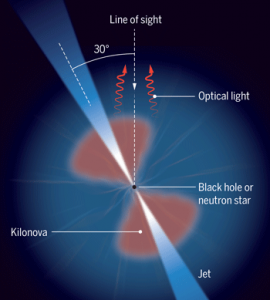Oct 19 2017
More Gravitational Waves
 The winner of the Nobel prize for physics was the detection of gravitational waves. These are extremely subtle ripples in spacetime caused by massive cataclysmic events, such as black holes colliding. These ripples were predicted by Einstein, who thought we may never be able to detect them because they would be so unbelievably tiny.
The winner of the Nobel prize for physics was the detection of gravitational waves. These are extremely subtle ripples in spacetime caused by massive cataclysmic events, such as black holes colliding. These ripples were predicted by Einstein, who thought we may never be able to detect them because they would be so unbelievably tiny.
How tiny? LIGO (Laser Interferometer Gravitational-Wave Observatory), the device used to detect the waves, can detect changes as small at 10 -22 meters. Graviational waves detected so far have had an amplitude of 10 -18 meters, smaller than the radius of a proton.
How is that possible? That is where the interferometry comes in. LIGO uses a laser split into two beams that will travel for 8 Km and then reflect off mirrors and come back to the same detector. The two beams have traveled the exact same distance so that they are in phase, or at least they can be calibrated to be exactly in phase, meaning that the peaks of the waves line up. When a ripple in spacetime comes through, the length of the two arms (which are at 90 degree angles to each other) will change slightly, bringing the two beams out of phase. That slight phase shift can be detected and measured.
Prior to winning the Nobel prize LIGO had detected four gravitational waves wash over it. This was considered enough of a confirmation of the technology and science to award the prize.
I admit I was a little surprised. The discovery is certainly worthy, but usually the Nobel committee is very conservative and they will wait for a discovery to stand the test of time. The little doubt I had in the back of my mind was that, in order to detect the tiny gravitational waves they have to eliminate all sources of even the slightest interference. Animals walking on the grounds of LIGO will cause a jitter in the detector.
While I had no doubt the instrument worked as advertised I admit to being a little worried about how certain they could be that all sources of artifact have been eliminated. The signal to noise ratio is miniscule, requiring virtually all noise to be eliminated or accounted for, and that always makes me suspicious.
Well, I think my doubts have now been assuaged. LIGO has detected a fifth gravitational wave event. More importantly, this detection was then confirmed (for the first time) by observing the event itself in various parts of the electromagnetic spectrum. As Science reports:
At 12:41 universal time on 17 August, physicists with three massive instruments—the twin 8-kilometer-long detectors of the Laser Interferometer Gravitational-Wave Observatory (LIGO) in Hanford, Washington, and Livingston, Louisiana, and the 6-kilometer Virgo detector near Pisa, Italy—spotted waves unlike any seen before. The four previous events lasted for, at most, a few seconds, with gravitational waves rippling at frequencies of tens of cycles per second. The new siren sang for 100 seconds at frequencies climbing to thousands of cycles per second. Whereas the earlier signal came from pairs of huge black holes quickly spiraling into each other, the new signal revealed lighter neutron stars, 1.1 and 1.6 times as massive as the sun, twirling inexorably together, researchers announced in parallel press conferences in Washington, D.C., and Garching, Germany.
Confirmation by three gravitational wave detectors is nice, but there’s more:
Because all three gravitational-wave detectors saw the signal, physicists could triangulate and locate the source to within a 30-square-degree patch of sky—about 60 times the size of the moon and much more precise than Fermi’s localization. Astronomers swiveled telescopes large and small to the spot in the constellation Hydra. The search got off to a slow start because that part of sky was in daylight for many observatories. But within hours, five groups had identified a new source of light in the periphery of galaxy NGC 4993, which they watched fade from bright blue to dim red in a matter of days. Nearly 2 weeks later, the source began to emit x-rays and radio waves.
The difference for this detection is that it was of neutron stars colliding, not black holes. Black holes are black, you can’t see them directly. But we can see neutron stars. They emit gamma rays, x-rays, and radio waves (what astronomers call an “optical counterpart”). This was no artifact – this was a real celestial event.
I appear not to be alone in my sentiments. Astronomer Andrew Howell is quoted as saying:
“Sometimes I wonder whether we’re all just mucking around,” Howell says. “It’s moments like this that reassure me that science works.”
This event had some more scientific pay dirt as well. The colliding neutron stars formed what is called a kilonova – thousands of times more bright than an ordinary nova.
Further, our models predict less production of heavy elements like gold and platinum in supernova than we actually observe in the universe. Where are those extra heavy elements coming from? It was hypothesized that they were coming from neutron start collisions like this one. Indeed – astronomers observed clouds of heavy elements around the kilonova – planets worth of gold and platinum.
I find it ironic that the ultimate gravitational wave confirmation comes so soon after this new science was awarded the Nobel. But it’s actually not that much of a coincidence. Once the detectors were up and running, the gravitational waves started coming in.
This is the birth of an entire new field of astronomy, a new way to image the universe. Yet again, Einstein is vindicated, and this time we actually exceeded his technological expectations. Sometimes we can be clever little apes.






